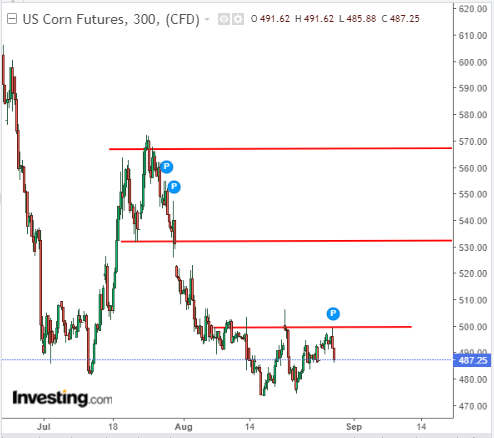Are Food Prices Staging a Rebound Amid Severe Draughts, Prolonged War?
2023.08.30 07:41
- High forecasted harvest for corn has increased supply, putting prices under pressure
- Meanwhile, oat prices have been affected by drought in Spain
- Wheat production continues to remain at high levels
According to a recent report by the German Federal Ministry of Food and Agriculture (BMEL), agricultural commodity crop planning is being significantly affected by the more frequent and severe droughts and floods caused by climate change.
The ongoing war in Ukraine is also creating uncertainty for agricultural producers. Russia’s exit from the Ukrainian export agreement and its attacks on Ukrainian infrastructure are posing serious problems as well.
However, there is a glimmer of hope in the form of solidarity corridors in Europe, which have already facilitated the export of over 45 million tons of various agricultural commodities.
Corn Prices Keep Heading Lower
prices are currently on a downward trend. The US Department of Agriculture predicts a global corn harvest for 2023 that’s expected to be around 5% higher.
This increase is primarily due to record harvests in Brazil, the world’s third-largest producer, and the US, the top producer. However, unpredictable weather patterns could lead to further revisions in forecasts, which have already been reduced by 11 million tons.
From a technical standpoint, there’s been an ongoing defense of a crucial short-term resistance at the $500 price range. A potential breakout at this level could provide an opening for buyers to target the $530 mark.

US Corn Futures 5-Hour Chart
Currently, the prevailing direction is the downtrend, and sellers will soon face the challenge of dealing with recent lows just above $470. If the downward movement continues, the next significant hurdle could emerge around the psychological barrier of $400, unless there’s a sudden collapse in production in the upcoming months.
Oat Production Outlook Getting Worse: Price Uptrend Set to Continue?
After hitting its lowest price levels since November 2020 in late April and early May, the price of is on an upward trend.
This shift is primarily attributed to adverse weather conditions, with drought notably impacting regions like Spain.
Given that Spain is the world’s third-largest producer of oats, following Russia and Canada, any crop issues in this country have global implications on valuations.
The current dynamic upward momentum is now aiming towards the resistance level situated around the $600 range.

Oats Futures Weekly Chart
The base scenario currently leans towards the continuation of the upward trend, with a potential setback if the price drops below the local support of $400.
Wheat Crop Forecasts Remain at Record Levels
The U.S. Department of Agriculture (USDA) has published an estimated harvest of 796.7 million tons, which remains higher than the previous year’s record.
Despite experiencing lower harvests in Russia, Ukraine, and Australia, there’s increased production in countries like Argentina, Canada, the EU, and India.
This compensates for the shortages caused by Russia’s actions against Ukraine. These factors contribute to the recent dynamic price declines, resulting in a renewed dip into the $600 range, last observed in early June.

US Wheat Futures 5-Hour Chart
The ongoing upward rebound, with its constrained momentum and notable response to the resistance level slightly above $620, can be categorized as a corrective movement. To confirm the potential continuation of the downtrend, a decisive drop below $570 is necessary, as this is where the recent lows are situated.
Bottom Line
Food prices are exhibiting mixed trends despite ongoing droughts and the prolonged Ukraine war, suggesting no clear overall rebound.
Corn prices are declining due to a projected increase in global harvests, driven by record yields in Brazil and the United States. Oat prices are rising because of adverse weather, particularly drought in Spain, a major oat producer. Wheat production remains high despite disruptions from Russia’s actions in Ukraine, and prices show a corrective rebound.
Although the future outlook remains unclear in light of the ongoing conflict and the effects of climate change, the European solidarity corridors provide a glimmer of optimism for agricultural exports in the forthcoming season. Moreover, resilient production in the American continent could keep the market more relaxed than previously thought in the mid-term.
***

Find All the Info you Need on InvestingPro!
Disclaimer: The author does not own any of these shares. This content, which is prepared for purely educational purposes, cannot be considered as investment advice








